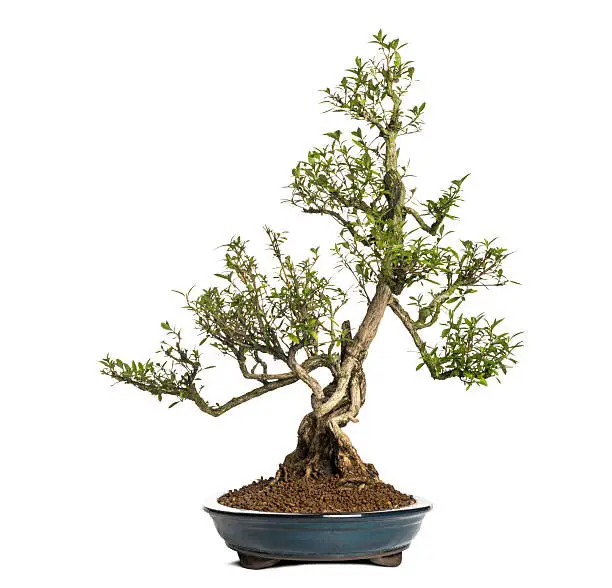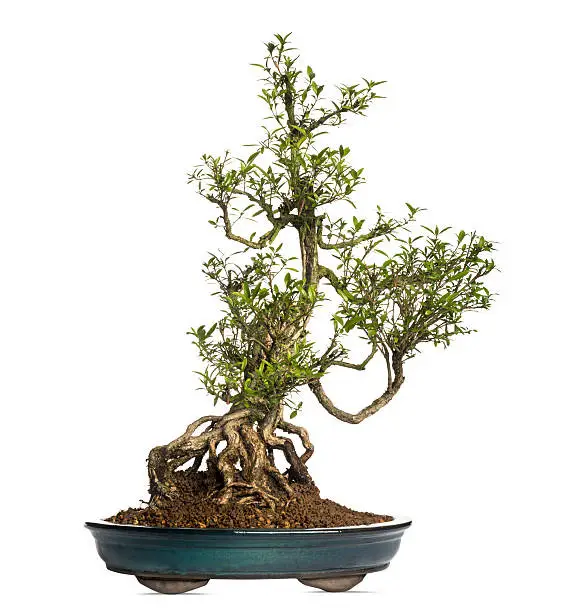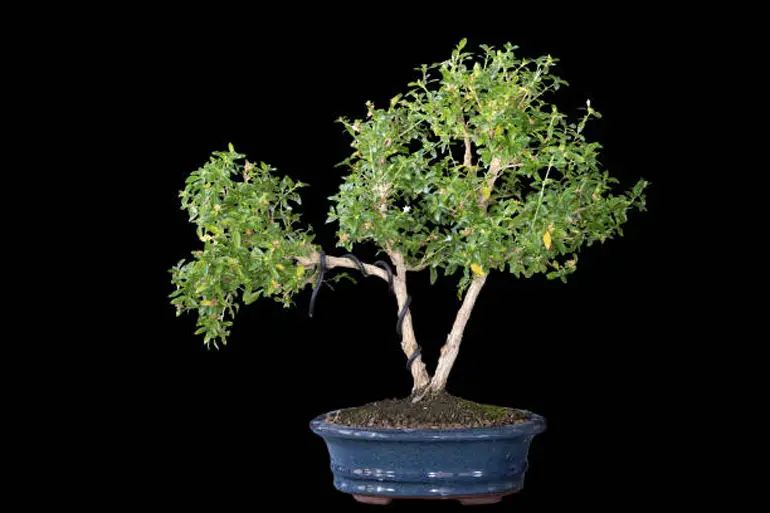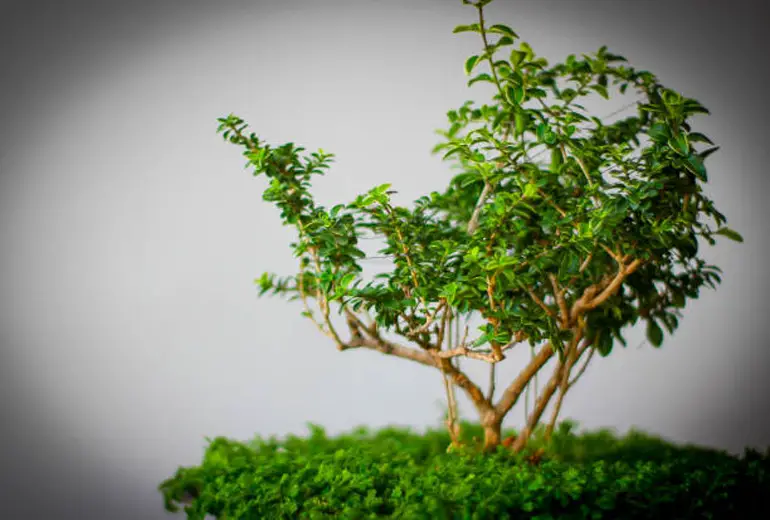Table of Contents
Let me quickly guess why you are here. You want to get some necessary information about the serissa bonsai plant, right?
Now don’t go anywhere because you are exactly where you should be. This article is a treasure of information related to the serissa bonsai plant.

Whether you need some general information about this plant or want to learn how to take its care, we have everything available for you!
| Scientific name | Serissafoetida OR Serissa japonica |
| Height of plant | 4 feet |
| Origin of plant | China, India, Japan |
| Watering | Moderate watering (Sensitive to over and under-watering) |
| Liquid Fertilizer | In low concentration every week during the growing season. |
| Solid Fertilizer | A small amount of solid organic fertilizer (every 4 weeks) Liquid fertilizer |
| Flowering | Small white flowers (2-3 times per year) |
| Soil | Well-draining fresh soil |
| Light requirements | Needs bright light |
| Indoor/Outdoor | Both (But make sure to provide bright light in both cases) |
Can we bonsai serissa plant?
The first most important question is that can we convert a serissa plant into a bonsai?
Yes, you can bonsai a serissa plant.
Serissa bonsai is a semi-evergreen or evergreen shrub that grows very beautiful tiny white flowers around 2 to 3 times per year. Due to the same reason, this plant is also called the “Tree of a thousand stars” in the bonsai community.
The serissa bonsai plant can be transformed into some very graceful and stunning styles.
These are the reasons why this plant is loved so much by bonsai enthusiasts.
Serissa bonsai history

The serissa bonsai plants are native to the wet meadows and sub-tropical woodlands of southeast Asia. More specifically, these plants originated from China, India, and Japan.
This plant is also known as “The Tree of Thousand Stars” or “Snow Rose”. The reason is that this bonsai plant grows tiny white flowers twice or thrice a year.
Maintaining this plant has not been so difficult from the beginning. However, this plant is sensitive to many environmental changes. Factors like overwatering, underwatering, too hot or too cold temperature can have a terrible impact on the health of your plant.
Serissa bonsai scientific name

The scientific name of a serissa bonsai plant is Serissa Japonica or SerissaFoetida.
The scientific name of any plant consists of two parts. The first part is the Genus name whereas the second part is the Species name of the plant.
The scientific community refers to a plant by its scientific name.
Serissa bonsai care

Are you planning to buy a serissa bonsai plant OR do you already have one?
In both cases, you need to learn how to take care of this plant if you want to grow it successfully. Otherwise, your plant won’t grow properly and you will end up killing it.
Luckily, we have everything for you. Here you will learn about every single aspect of taking care of a serissa bonsai plant.
Serissa bonsai temperature
What is the safe and healthy temperature for a serissa bonsai plant?
Well, the serissa bonsai plants prefer a wind-protected and sunny spot. During the growing season, you can place Serissa bonsai plant outside as long as the temperature is higher than 10℃ OR 50℉.
The serissa bonsai plant cannot tolerate any drastic rise or drop in temperature. Therefore, you should avoid changing its position frequently.
When it’s winter, you should place the serissa bonsai plant inside your house. The temperature must be between 10℃ (50℉) to 20℃ (68℉).
If the location of your plant is warmer, you will need more light. You can take the help of modern grow lights. Plus, you are also advised to keep the humidity high.
Serissa bonsai fertilizer
What is the correct way to fertilize a serissa bonsai plant?
The experts recommend that you should give a small quantity of solid organic fertilizer to your plant after every 4 weeks.
How about using a liquid fertilizer?
Well, you can also use a liquid fertilizer every week during the growing season but it should be in low concentration.
Your fertilizer should have a balanced ratio of Potassium, Phosphorus, and Nitrogen.
In winter, you should fertilize your serissa bonsai plant once a month by using a low dose of liquid fertilizer. However, the tree must be kept in a warm place if you want to fertilize it.
We strongly recommended you never fertilize any serissa bonsai plant that is unhealthy or not growing.
Serissa bonsai pruning/trimming
Pruning is very important for the styling of a bonsai plant. But before you start pruning your precious bonsai plant, you need to know all dos and don’ts. It will help you keep your plant safe and avoid any kind of damage.
So, what you should know about pruning the serissa bonsai plant? Let’s start!
How to prune serissa bonsai?
The serissa bonsai plant can tolerate hard pruning very well. You are recommended to perform the pruning in early spring. You can prune the plant and shape it the way you like.
A young tree is trimmed back to 2 leaves when its shoots have grown at least 4 to 5 leaves.
In the case of older trees, they should be trimmed less until they are flowering. However, you should prune them thoroughly after flowering.
You should cut the branches back to the old wood after every 2 to 3 years. Doing this will help you keep your tree shape compact. You can wire the shoots and branches of your plant at any time. However, you should be careful as they are quite delicate.
Serissa bonsai repotting
Repotting can be very healthy for your bonsai plant if you will do it in the right way and at the right time.
You are recommended to re-pot your serissa bonsai plant after every 2 years only. When repotting, you should only use a standard mix of soil to keep your serissa plant healthy and safe.
Keep in mind that if you will cut the roots, they start giving out an extremely unpleasant smell.
Serissa bonsai pests and diseases
Different pests and diseases can attack your serissa bonsai plant and kill it at any time. You need to beware of the enemies of your plant and know how to control them.
Root aphids, spider mites, and aphids can easily attack for serissa bonsai plant. In such a case, you are advised to use any specific pesticide of good quality and also increase the humidity.
Overwatering the serissa bonsai plant OR using poor soil quality can cause the plant’s roots to rot. In such a case, we advise you to re-pot the serissa bonsai plant, cut off all the damaged roots, and plant it again in well-draining fresh soil.
Serissa bonsai soil
Like we told you above that the roots of your serissa bonsai plant will start rotting if you will use the wrong soil for your plant.
Therefore, you need to provide healthy soil to your bonsai plant.
Best soil for serissa bonsai
Well, the serissa bonsai plants always prefer fresh and well-draining soil that is enriched with nutrients.
Such soil will keep your plant healthy and promote its growth.
Serissa bonsai watering
Watering is a matter of life or death for every bonsai plant including the serissa bonsai.
This plant is sensitive to both underwatering and overwatering.
Underwatering can cause this plant to lose its leaves and even die in extreme cases. Similarly, overwatering can rot the roots of this serissa bonsai plant.
Therefore, correct watering is extremely important for your plant. Let’s find out how to correctly water your plant:
How often to water serissa bonsai?
You should keep the rootball of your plant moist most of the time. However, you should avoid overwatering at the same time.
The plant should not be left to dry out completely. You should also avoid giving calcareous water to your plant because the serissa bonsai plant likes a neutral pH value. Moreover, when there are no flowers left on the tree, you can consider spraying lime-free water on the foliage of your serissa bonsai plant.
How to water serissa bonsai?
Start with checking the moisture level in the soil by using your fingers.
Just stick one of your fingers deep into the soil. If you feel that the bottom layer of the soil is nearly dry and barely moist then you should give a nice long drink to your serissa bonsai plant.
Serissa bonsai sunlight requirements
Sunlight is the main source of food for every single plant including your serissa bonsai. It helps the plant to perform photosynthesis and prepare its food to survive.
We recommend you place your serissa bonsai plant somewhere where it can get bright light. This plant can tolerate direct sunlight very well.
During the summer months (June-September) you should keep your plant outside so it can get plenty of sunlight. A half-shade would be a good option.
Even during winter, you should keep your plant at a bright location. The thumb rule is that the warmer the location, the brighter the light should be.
Serissa bonsai types
Since the serissa bonsai plant is found in multiple places like China, India, and Japan, that’s the reason why this plant has several different types.
Each of them has unique traits that make them different from the other types of the same plant.
Let’s go and take a quick look at all of them now.
Serissa japonica (snow rose) bonsai
This is one of the most common and widely found species of the serissa bonsai plant. The reason why this plant is called a snow rose is that it grows tiny white flowers 2 to 3 times per year.
Those small white flowers resemble snow and that’s why we call them snow rose bonsai plants.
Variegated serissa bonsai
The scientific name of this plant is Serissa foetida. The leaves of this plant are small and smooth from the edges.
This tree has a beige-colored bark that looks extremely beautiful. People also call it “The Tree of Thousand Stars” due to the cute white flowers it grows.
Pink serissa bonsai
This is a wonderful indoor bonsai plant that is very famous in the bonsai community. The reason is that this serissa bonsai grows pink flowers that are relaxing and pleasant for your eyes.
Are serissa bonsai indoor or outdoor plants?
Can you grow a serissa bonsai plant indoors OR you should keep it outdoors only?
The experts say that the serissa bonsai plant can be grown indoors too. However, you need to provide bright light to them.
The reason is that these plants need a lot of light. You can also use grow lights for bonsai if there’s a need OR you can keep them near a window where they get bright light.
The serissa bonsai plant will grow very well even if you place it outdoors during the summer months.
How big do serissa bonsai get?
You’ll be very interested to know how big serissa bonsai plants can grow?
Research says that the serissa bonsai plant can grow as big as up to 4 feet if you will take good care of it.
Regular maintenance and pruning are required to keep the plant in shape.
How fast does serissa bonsai grow?
How fast your serissa bonsai plant will grow depends upon how well you take care of it. If you are not giving any time to your plant then its growth will either stop or it’ll be extremely slow.
On the other hand, if you will take good care of your plant as per our instructions then experts say that your plant can grow 5 to 10 centimeters per month during summer.
But you will have to take care of watering, fertilization, and other necessary maintenance.
How to make a serissa bonsai tree?
Generally, there are 2 to 3 ways for making a serissa bonsai plant.
You can make a serissa bonsai plant:
- By cutting.
- By seeds.
- By using another uprooted plant.
We will discuss them now.
How to make serissa bonsai from cutting?
In this method, you take a cutting of another healthy serissa bonsai plant, dip it in growth hormone, and then plant it inside a suitable soil mixture. Then you provide it extreme care and wait for the plant to grow.
After a couple of weeks, the roots start forming, and eventually, it grows into a complete plant.
The benefit of using cuttings is that your new plant will be exactly similar to the plant whose cuttings you have used. This method is useful when you want to get an exact copy of a plant that you like.
How to make serissa bonsai from seeds?
In this method, you take seeds of a serissa bonsai plant and sow them in suitable growing soil.
The seed grows after some time and then develops into a plant.
You will have to take good care of the seed and use the right techniques to make it grow.
How to make serissa bonsai from another uprooted plant?
In this method, you take a small serissa bonsai plant that has been carefully uprooted and can be regrown.
You have to plant it into suitable soil and then take care of it as per our instructions above. The plant will eventually grow into a full serissa bonsai plant.
How to grow a serissa bonsai tree?
If you have bought a serissa bonsai plant and want to grow it then you have to take care of it the right way.
It involves many factors altogether like:
Watering, fertilization, repotting, pruning, healthy soil, prevention from pests and disease, etc.
We have provided you with detailed guidelines on every aspect of taking care of a serissa bonsai plant in this article. Make sure to follow them and you will be able to grow your plant successfully.
Why are my serissa bonsai leaves turning brown?
The answer is simple = Improper care.
The reason why your serissa bonsai leaves are turning brown is that you are making some mistakes while taking care of this plant.
Here are the main reasons:
1. Watering problems
This plant is sensitive to overwatering and underwatering.
Overwatering will rot its roots and cause the leaves to turn brown.
Underwatering will cause the plant to dry out and its leaves will turn brown and eventually fall.
Moderate watering is the key.
2. Fertilization
Using the wrong fertilizer OR using the wrong amount of fertilizer OR not fertilizing the plant at all.
All these cases can make your plant leaves brown. You should fertilize it with a small quantity of solid organic fertilizer after every 4 weeks.
3. Unhealthy soil
Using the wrong soil will directly impact the health of your plant and turn its leaves brown. This plant needs fresh well-draining soil.
4. Poor lighting
Serissa bonsai plant needs bright light.
If you have kept it in darkness and do not provide any light to it then its leaves will turn brown and fall.
Give it enough light, please.
5. Pests and diseases
Attack of pests and diseases can also turn the color of the leaves of your plant and make it brown.
You need to treat your plant on time.
What to do if my serissa bonsai is dying?
You need to identify the root cause of this problem. Find out why your bonsai plant is dying.
Here are some possible scenarios:
If it is due to under watering or overwatering, you need to give the right amount of water as we told you above.
If it’s due to poor light, you should give plenty of bright light to your plant.
If there is a soil problem, you need to use the right soil.
If it is a lack of fertilization then you have to use the right amount of the right fertilizer at the right time.
If it is due to insects or disease attacks then you need to treat your plant accordingly.
If the roots of your plant have been damaged, then you should cut the damaged parts of the roots and then repot the plant in suitable soil.
![Pittosporum Bonsai [Pittosporum Tobira]](https://www.bonsai-express.com/wp-content/uploads/2022/05/Pittosporum-Bonsai-365x200.jpg)
![Sorbus Bonsai [Sorbus Aucuparia]](https://www.bonsai-express.com/wp-content/uploads/2022/05/Sorbus-Bonsai-365x200.jpg)
![Tsuga Bonsai [Tsuga Canadensis]](https://www.bonsai-express.com/wp-content/uploads/2022/05/Tsuga-Bonsai-365x200.jpg)
![Tamarix Bonsai [Tamarix Ramosissima]](https://www.bonsai-express.com/wp-content/uploads/2022/05/Tamarix-Bonsai-365x200.jpg)